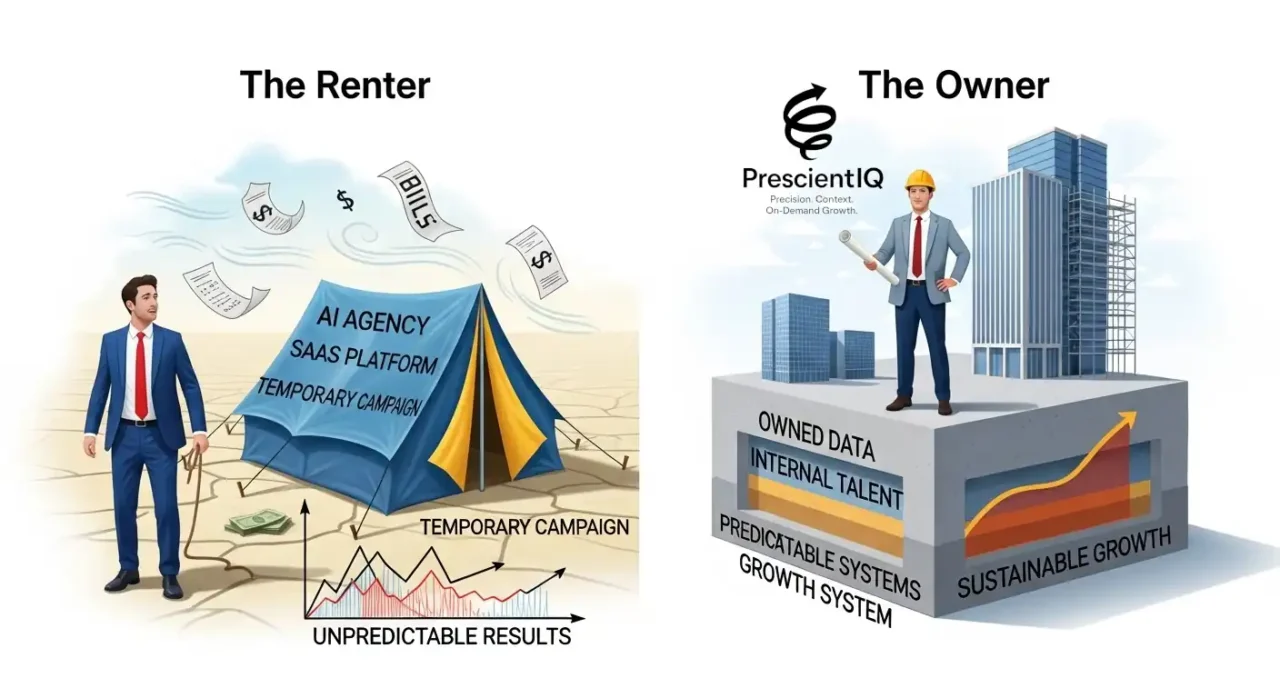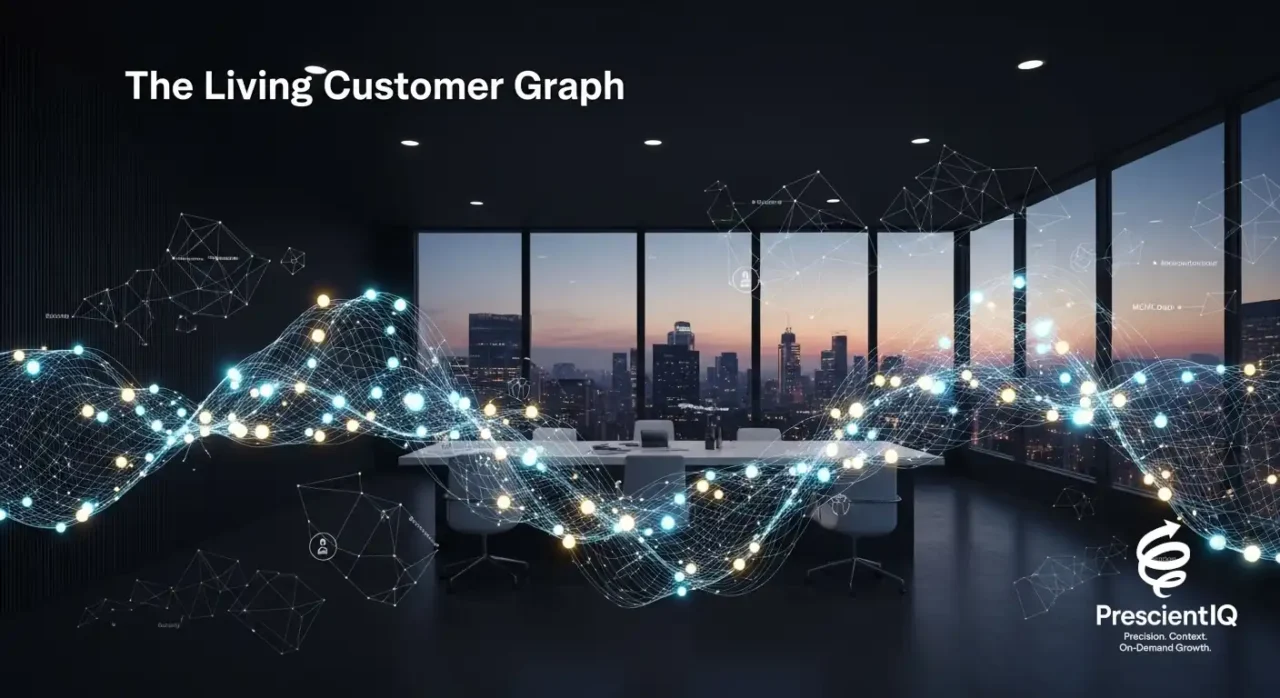Unlocking Predictive Growth: The Power of Monte Carlo Markov Chain in Marketing
Unlocking Predictive Growth: The Power of Monte Carlo Markov Chain (MCMC) in Marketing.
Leveraging Probabilistic Modeling for Autonomous Growth and Causal Intelligence.
I. Executive Summary / Abstract
This article explains how advanced probabilistic modeling, specifically the principles of the Monte Carlo Markov Chain (MCMC), enables predictive marketing and “Unified Causal Intelligence” for autonomous growth.
Traditional marketing suffers from uncertainty and a lack of statistical rigor, whereas MCMC provides a framework for navigating high-dimensional data, shifting from reactive analysis to proactive, causal foresight.
MatrixLabX’s PrescientIQ platform leverages MCMC-like simulation to deliver precise, real-time campaign optimization, enabling predictable, on-demand growth.
The target audience includes CMOs, AI strategists, and B2B marketing leaders seeking to build predictable growth engines.
II. Introduction: The Context and the Stakes
The current “Era of Marketing Chaos” is characterized by fragmented data, siloed tools, and pressure to react to market dynamics, resulting in unpredictable outcomes and difficulty connecting marketing actions to revenue.
Rapid technological advancements and evolving consumer behaviors exacerbate these challenges, rendering old marketing playbooks obsolete. MatrixLabX observes a common frustration: marketing efforts that lack measurable, predictable ROI are often treated as a cost center. The market demands deep, causal intelligence—understanding the “why” behind marketing actions—rather than mere automation.
The article posits a scenario where marketing systems can predict future market shifts with statistical certainty and simulate actions to proactively shape outcomes, turning market uncertainty into a competitive advantage.
III. The Problem: Breaking Down the Paradox

The marketing landscape presents a paradox: abundant data but a scarcity of insight, sophisticated AI tools but unpredictable outcomes, and a persistent reactive loop.
More data and automation are insufficient; true predictive power requires deeper, probabilistic intelligence. Marketers face information overload, data integration challenges, and talent gaps in advanced analytics.
A significant hurdle is distinguishing true causation from mere correlation in complex customer journeys and campaign performance, which can lead to misguided strategies.
Common CMO struggles include confidently answering “what if” questions about budget increases or future lead generation from specific content topics.
The “black box” nature of many AI tools, exemplified by the statistic that “68% of content produces zero leads” due to a lack of understanding of their impact, undermines trust and decision-making.
The solution lies in a new paradigm of predictive marketing grounded in probabilistic intelligence.
IV. The Framework: Introducing the PrescientIQ Model
PrescientIQ offers “Unified Causal Intelligence,” an autonomous operating system for proactive simulation and shaping of future outcomes, moving beyond reactive correlations.
Its core is the “Quantum AI Loop,” a self-reinforcing cycle of continuous learning and optimization, based on the understanding that the future is a range of probabilities that can be influenced.
MatrixLabX’s approach fuses AI automation with human strategic oversight.
PrescientIQ uses sophisticated AI models, informed by advanced statistical methods such as MCMC, to provide “glass-box transparency,” enabling strategists to understand prediction drivers and intervention methods and fostering human-machine collaboration. This augments human intuition with data-driven insights.
The framework can be visualized through the “Quantum AI Loop” or the “4S Framework” (Streaming, Scrolling, Searching, Shopping), illustrating how PrescientIQ maps and optimizes non-linear customer journeys through robust, probabilistic modeling of interconnected touchpoints.
Below is a board-level explanation of both concepts—the Quantum AI Loop and the 4S Framework—written in a way that is strategic, concise, and aligned with executive decision-making.
Board Briefing: Quantum AI Loop & The 4S Framework
Transforming Marketing from a Cost Center into a Predictive Growth Engine
1. The Quantum AI Loop
A self-improving intelligence system that compounds growth autonomously.
Think of the Quantum AI Loop as a closed-loop, continuously learning engine that removes guesswork from marketing decisions. Instead of running campaigns and hoping for results, the system observes, predicts, adjusts, and optimizes in real time.
How It Works (Board-Level Explanation)
1. Observation
Every user interaction—view, click, scroll behavior, purchase signal—is captured as a probabilistic “moment.”
Rather than static analytics, the system uses probability distributions that dynamically shift as new data arrives.
2. Prediction
Using MCMC and Bayesian models, the AI estimates the likelihood of revenue outcomes before spending a dollar.
This mirrors how financial markets price future value—not how marketers typically guess at performance.
3. Action
The system autonomously deploys content, ads, and offers based on the most probable profitable path.
No human bias. No departments arguing. No dashboards to interpret.
4. Reinforcement
Outcomes feed back into the model, strengthening future predictions — exactly like a hedge fund algorithm.
Why It Matters to the Board
- Turns marketing from a volatile OpEx into a predictable, compounding asset
- Reduces reliance on large teams and agencies
- Guarantees revenue outcomes with quantifiable probability
- Creates a defensible competitive advantage that strengthens with every iteration
The Quantum AI Loop is essentially an autonomous growth infrastructure, not “marketing technology.”
2. The 4S Framework (Streaming → Scrolling → Searching → Shopping)
A new model for understanding and influencing the modern consumer journey.
Traditional funnels are dead. Consumers no longer move from awareness → consideration → purchase in a straight line.
Instead, they cycle through micro-moments across four universal digital behaviors:
1. Streaming
Passive consumption: YouTube, Netflix, TikTok, podcasts. This is where attention is captured and brand memory is formed.
2. Scrolling
Fast, habitual, social feed behavior: LinkedIn, Instagram, X. This is where curiosity is sparked and affinity begins.
3. Searching
Intent-driven behaviors: Google, YouTube search, Amazon search. This is where the “moment of truth” emerges — a signal of commercial intent.
4. Shopping
E-commerce and transactional environments. This is where buying decisions are finalized and loyalty is reinforced.
Why It Matters to the Board
- Replaces outdated funnel thinking with a model aligned to how customers actually behave today
- Enables precision targeting at each stage using probabilistic causal models
- Dramatically improves capital efficiency by spending where profit signals are highest
- Supports autonomous growth systems (like the Quantum AI Loop) by mapping behaviors to outcomes
In Practical Terms
The 4S Framework gives the AI Loop the structure it needs to:
- Detect early purchase signals
- Intervene at the highest ROI touchpoints
- Use MCMC to predict revenue probability across behaviors
- Automate the entire growth cycle with minimal human input
What This Means for the Board
1. Predictability
Marketing spend becomes forecastable with a “probability band” that the CFO can model.
2. Efficiency
Large marketing teams can be downsized or repurposed. Agency fees are reduced or eliminated.
3. Accountability
Every dollar is tied to expected revenue, not activity metrics.
The “What-If” Engine
A CEO’s Guide to B2B Marketing Simulation
Executive Summary
This tool simulates 100,000 target leads moving through your B2B marketing funnel over 50 “weeks.” It uses a statistical method (a Monte Carlo Markov Chain) to predict the most likely outcome of your strategy.
How to use it:
- Enter the Average Annual Value (LTV) of a closed-won customer.
- Run the simulation for your current numbers.
- Click “Save as Baseline” to lock in those results.
- Change a slider (your “lever”) and run the simulation again to see the revenue impact.
Your Marketing Levers
Weekly chance an ‘Aware’ lead becomes an MQL.
Weekly chance an MQL becomes an SQL. (2% weekly decay assumed)
Weekly chance an SQL is Closed-Won. (1% weekly decay assumed)
The *annual* retention rate. This is converted to a weekly rate for the sim.
Lead Distribution Over Time (Weeks)
Final “Steady State” (After 50 Weeks):
4. Competitive Advantage
Most companies still rely on intuition, agencies, and dashboards. You’ll rely on causal intelligence, probabilistic modeling, and autonomous decision loops.
5. Strategic Leverage
This is not a tool; it’s a system that transforms marketing from a volatile cost center into a predictable, financial lever for growth.
V. Core Insights: The Statistical Engine of Predictive Foresight

PrescientIQ’s predictive power stems from its statistical engine, inspired by Monte Carlo Markov Chain (MCMC) principles.
From Raw Data to Predictive Intelligence: The MCMC Advantage
MCMC algorithms are crucial for sampling from complex probability distributions, playing a foundational role in Bayesian inference and handling high-dimensional, intractable data in marketing. Traditional methods struggle with the complexity of marketing data, but MCMC extracts meaningful insights.
MCMC methods construct a Markov chain, a sequence of random variables where the next variable’s probability depends only on the current one, converging to the target probability distribution to reflect system dynamics accurately.
This enables insights into system behavior and future state.
This statistical power supports PrescientIQ’s “pre-factual simulation” capability, allowing businesses to test strategies before implementation and answer “what if” questions with confidence. PrescientIQ delivers “forecasts within 3–7% of actuals.”
The Human-AI Collaboration Model: Navigating Complexity with “Glass-Box” Clarity
The probabilistic output of MCMC quantifies uncertainty, providing “glass-box transparency” that empowers human marketers.
This transparency builds trust and fosters human-machine collaboration, allowing marketers to interpret, validate, and apply AI-driven insights, promoting creativity and critical thinking. MatrixLabX emphasizes human oversight, viewing AI as an augmentation tool.
The “glass-box” nature allows marketers to understand AI prediction reasoning, enabling informed decisions, unlike “black box” systems. This transparency allows drilling down into specific influencing factors.
Ethical considerations, such as data privacy, algorithmic fairness, and potential unintended consequences, are addressed through human oversight, ensuring responsible AI use.
Scaling Authenticity and Trust with Probabilistic Certainty
Robust predictive modeling, informed by MCMC rigor, enables brands to consistently deliver relevant and trustworthy content and experiences (E-E-A-T).
Consumers are increasingly skeptical, favoring genuine and trustworthy brands. PrescientIQ’s causal impact understanding ensures brand voice consistency and transparent engagement, reducing irrelevant retargeting or generic messaging.
A Healthcare SaaS client using PrescientIQ’s MCMC-powered simulations predicted which content formats would resonate with buyer personas, leading to a 20% increase in qualified demo bookings and stronger trust in a regulated industry.
This demonstrates how predictive marketing builds stronger customer relationships and drives measurable results by tailoring content and messaging to individual needs and interests.
VI. The MatrixLabX Solution in Action: PrescientIQ Powers Predictive Growth

MatrixLabX platforms, such as PrescientIQ, operationalize these principles by seamlessly integrating with existing marketing technology stacks.
- Predictive SEO via AISEOPad™: Identifies high-potential keywords and content gaps months in advance by predicting search trend shifts with statistical confidence.
- AIPlanPad: Fuels strategic marketing plans with dynamic scenario simulations and probabilistic forecasting for optimal budget allocation and channel strategy.
- Strategic Long-Form Creation with AIContentPad™: Guides content generation based on predicted audience intent and conversion likelihood for maximum impact.
- Continuous Optimization with NeuralEdge™: Enables real-time adaptation and fine-tuning of campaigns and customer journeys, leveraging updated probabilistic models for greater efficiency and ROI.
PrescientIQ delivers “Forecasts within 3–7% of actuals” and has achieved results like a “33% bounce rate reduction in 90 days” and a “28–41% increase in qualified meetings” by providing causal intelligence.
VII. Challenges and Considerations: Taming the Probabilistic Beast
Implementing sophisticated MCMC models presents challenges, including computational cost and complexity. Rigorous model validation is essential, and potential bias arises if the underlying data are flawed.
Over-automation must be prevented. MCMC models can be computationally intensive, requiring significant processing power and memory, and are challenging to validate and interpret.
Accurate and representative training data are crucial to avoid biased predictions. MatrixLabX emphasizes that AI augments human intelligence; human strategists are vital for interpreting insights, setting ethical guardrails, and providing creative direction.
Guidance for safe experimentation and governance is paramount, recommending well-defined pilots, clear KPIs, and strong data governance policies.
VIII. The Future of Thought Leadership: Beyond Prediction to Proactive Shaping
The future of marketing involves the convergence of AI, advanced probabilistic modeling (including emerging quantum-enhanced MCMC techniques), and sophisticated human creativity, redefining market leadership from reactive to proactive market shaping.
Quantum-enhanced MCMC techniques promise improved predictive performance of marketing models through accelerated sampling and the overcoming of classical limitations.
The question for marketing leaders is how to make their systems learn faster than the market and actively orchestrate it for sustained, exponential growth. The future of marketing is about creating, not just predicting.
IX. Conclusion: Seize Your Predictive Advantage
The article contrasts the chaotic nature of fragmented marketing data with the strategic clarity offered by deep probabilistic modeling.
Understanding MCMC’s power demonstrates how PrescientIQ transforms marketing from an unpredictable cost center into a predictable, autonomous growth engine.
This journey empowers marketers to control their destiny. The future of marketing is active, enabling marketers to shape their success.
The reality where marketing systems predict and act on market shifts with statistical certainty is accessible with MatrixLabX, urging readers to seize their predictive advantage now.
Explore PrescientIQ’s Unified Causal Intelligence


